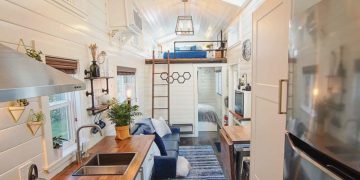When you’re expecting a new addition to the family, you can expect that your new little one is likely to uncover a hidden hazard or two in your home during their first few years of life. You might be surprised to know the potential dangers lurking in your cabinets, low-to-the ground storage spaces, and nooks and crannies of your house that little hands can discover. Since September is National Baby Safety Month, we’ve gathered together some expert advice on safe storage and baby proofing the home. We hope these tips make you aware of a few ways you can improve the safety of your home for babies, toddlers and young kids, but of course, close supervision by adults is always the safest way to protect your kids from running into trouble with household items.

Cleaning Product Storage
Cleansers, detergents, bleaches, sprays, powders and most other household cleaning products can be poisonous to babies. In many homes, these types of products are stored in low-to-the-ground places like under sinks or in basement closets. Get these products off the ground and store them in a high up, unreachable place like a shelf as soon as possible. When you move cleaning products to a new storage location, make sure the place you’re moving them from is cleaned thoroughly. Detergents and solutions may have dripped out or left a residue in cupboards over the years that can be harmful if touched by children.
If you have an old shoe rack, you can repurpose it to store cleaning products on the back of a closet door. Just make sure it’s high enough to be out of reach of your child.
Installing Latches
It’s a smart idea to install child-guard latches on all drawers and cabinets that your little one can reach. This is especially important in places like the kitchen, bathroom, basement and laundry room where you might store cleaners, medications, tools, sharp objects or any potentially harmful substances. Fortunately, child-proof locks and latches are inexpensive (most are well under $20) and can be found at many popular stores like Home Depot, Lowes, and Babies R Us.

Image via SheKnows.com
Pools
This time of year, many people are closing up their pools and bringing all their pool accessories indoors for the colder months. Now is good time to go through a pool safety checklist and make sure your pool and the place where you store your pool chemicals are baby-proof. For pools and hot tubs, the Consumer Product Safety Commission has several safety recommendations when it comes to storage and maintenance:
- Enclose it with a locking 5 foot fence
- Cover it completely with a safety cover
- Activate alarms on all doors leading from the house to the pool area
- Make sure pool toys are stored and locked away when not in use.
Not only is it important to take safety precautions when maintaining and storing your actual pool, it’s also just as important to properly store your pool chemicals, especially when you have small children around. Contac t with pool chemicals can be extremely dangerous, and improper storage of chemicals can result in dangerous chemical reactions and release of harmful gases. Make sure your pool chemicals are locked up in a place where they won’t have contact with water. To prevent water contact with stored chemicals, the Environmental Protection Agency has the following recommendations:
- Close containers properly
- Cover opened or damaged packaging
- Store chemicals away from doors and windows
- Ensure that there are no roof leaks, open or broken windows, or leaks from water pipes, hoses, or the sprinkler system
- Ensure that floors are sloped to keep water drained away
- Store chemicals on shelves or pallets to keep containers off the floor
- Use waterproof covers on packaging
- Exercise particular caution to prevent water contact with stored chemicals any time water is
used for cleanup of floor areas near stored packages - Ensure that water will not back up from faulty or clogged floor drains.
For more tips on safe maintenance of pools, visit http://www.poolsafely.gov/.
Other Baby-Proofing Tips
- Sharp Corners and edges: Place objects that are sharp or can be broken up high and out of reach. Pad sharp corners of furniture.
- Furniture: Bolt armoires and bookshelves to the walls. This is especially important for older and/or unsturdy furniture.
- Outlets: Instead of using outlet plugs, which can be a choking hazard, remove existing outlet plates and replace them with safety plates like this one that automatically cover the outlet when the plug is removed.
- Toilets: Just as you’d put latches on cabinets, cupboards and drawers, it’s important to put to put toilet locks like these on toilet bowl covers to prevent babies from touching the water.

- Railings: Children can get their heads caught in railings that are set too wide. According to modern building codes, railings should not be more than 3.5 inches apart. If your railings are wider than that, you may want to consider installing Plexiglas, netting, or another temporary barrier over the bars.
- Temporary Dangers: When a baby is in a room, immediately remove/lock up/put out of reach common household items like portable heaters, buckets of water, cleaning products, or scissors.
The best way to make sure you haven’t missed anything inside the house that is potentially dangerous to a small child is to get on the same level as them. Get down on your hands and knees and crawl through your house and see what your child is seeing. Have you overlooked anything?
For more expert tips on baby proofing your home, visit BabyCenter.com, Parents.com and WebMd.







